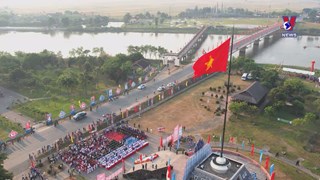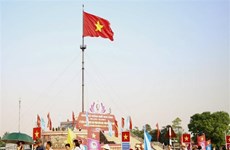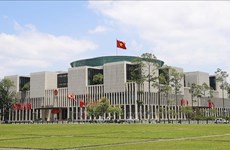Hanoi master plan under scrutiny
National Assembly deputies yesterday heard a Government report on
Hanoi's master plan for development until 2030 with a vision to 2050 — a
document that has presented a number of thorny problems to developers
and city planners alike.
National Assembly deputies yesterday heard a Government report on
Hanoi's master plan for development until 2030 with a vision to 2050 — a
document that has presented a number of thorny problems to developers
and city planners alike.
Presenting the master plan, Minister of Construction Nguyen Hong Quan said that the GDP growth rate of Hanoi would be approximately 8 percent between 2020 and 2030, with GDP per capita reaching about 11,000 USD in 2030.
In 2030, the population would hit 9 to 9.2 million, and land needed for construction in rural areas would reach between 39,000 and 40,000ha. According to the report, housing spaces in urban areas will rise to more than 30sq.m per person and the urbanisation ratio will be at around 70 percent.
Under the master plan, the capital will be built in line with a sustainable development model. The core urban centre will be linked with five satellite urban areas and other towns in the surrounding rural areas.
The core urban centre will be formed by the east-west axis of the Thang Long, Highway 32, Lang-Hoa Lac Highway and Highway 6. Of which, the Thang Long axis will connect with Hoang Quoc Viet Road, Highway 21, West Lake and Ba Vi areas. It will become the main traffic axis in the transportation corridor.
The national political centre will also remain in Ba Dinh District. Land has been set aside for development of the Government and administrative offices in Ba Vi until 2050.
And the national administrative centre will remain around Hoan Kiem Lake .
Total investment capital for infrastructure development from 2010 to 2030 is approximately 60 billion USD. Transportation will cost 33.3 billion USD. By 2050, investments will further increase by 29.9 billion USD, of which transport will account for 16.8 billion USD.
According to Quan, by collecting ideas from NA deputies, the Government will require consultant companies to complete the master planning before submitting it to the Prime Minister for approval in August.
Delivering a report on the collected opinions, chairman of the National Assembly's Economics Commission Ha Van Hien proposed telling the public to be aware of the correct orientation of the master plan so as to avoid disturbances of the mind.
It would also help to prevent skyrocketing prices in land and real estate. Especially, it should prevent the effects of improper interest groups that could influence the project's direction.
The commission also asked for further clarification on urban space orientation, the new administrative centre and the Thang Long axis, as well as the north-south axis.
The new national administrative centre had raised concern from some deputies, who said that if the administrative centre was moved from Hanoi to Ba Vi, it might not suit the elements of history, culture and national defence; therefore, the political centre should remain in Ba Dinh district.
Others said that the administrative centre should not be separated from the national political centre. They added that it should be in only one place. Therefore, moving these areas to Ba Vi would be a thorny problem that needed to be thoroughly scrutinised and have a public consensus.
Regarding the 90 billion USD total investment in infrastructure development from 2010 to 2050, the commission told NA deputies that the calculation should be more carefully considered, based on the work to be done so as to achieve the goals of the plan.
Capital investments in infrastructure development for the master plan needed to be balanced with the total investment capital for the country's other projects such as nuclear power plants and the Hanoi-HCM City express railway.
To ensure the master plan would be made in a serious manner and would not affect livelihoods, production or investments during the process, the commission also proposed to have separate documents on management regulations of the master plan in accordance with the Law on Urban Planning./.
Presenting the master plan, Minister of Construction Nguyen Hong Quan said that the GDP growth rate of Hanoi would be approximately 8 percent between 2020 and 2030, with GDP per capita reaching about 11,000 USD in 2030.
In 2030, the population would hit 9 to 9.2 million, and land needed for construction in rural areas would reach between 39,000 and 40,000ha. According to the report, housing spaces in urban areas will rise to more than 30sq.m per person and the urbanisation ratio will be at around 70 percent.
Under the master plan, the capital will be built in line with a sustainable development model. The core urban centre will be linked with five satellite urban areas and other towns in the surrounding rural areas.
The core urban centre will be formed by the east-west axis of the Thang Long, Highway 32, Lang-Hoa Lac Highway and Highway 6. Of which, the Thang Long axis will connect with Hoang Quoc Viet Road, Highway 21, West Lake and Ba Vi areas. It will become the main traffic axis in the transportation corridor.
The national political centre will also remain in Ba Dinh District. Land has been set aside for development of the Government and administrative offices in Ba Vi until 2050.
And the national administrative centre will remain around Hoan Kiem Lake .
Total investment capital for infrastructure development from 2010 to 2030 is approximately 60 billion USD. Transportation will cost 33.3 billion USD. By 2050, investments will further increase by 29.9 billion USD, of which transport will account for 16.8 billion USD.
According to Quan, by collecting ideas from NA deputies, the Government will require consultant companies to complete the master planning before submitting it to the Prime Minister for approval in August.
Delivering a report on the collected opinions, chairman of the National Assembly's Economics Commission Ha Van Hien proposed telling the public to be aware of the correct orientation of the master plan so as to avoid disturbances of the mind.
It would also help to prevent skyrocketing prices in land and real estate. Especially, it should prevent the effects of improper interest groups that could influence the project's direction.
The commission also asked for further clarification on urban space orientation, the new administrative centre and the Thang Long axis, as well as the north-south axis.
The new national administrative centre had raised concern from some deputies, who said that if the administrative centre was moved from Hanoi to Ba Vi, it might not suit the elements of history, culture and national defence; therefore, the political centre should remain in Ba Dinh district.
Others said that the administrative centre should not be separated from the national political centre. They added that it should be in only one place. Therefore, moving these areas to Ba Vi would be a thorny problem that needed to be thoroughly scrutinised and have a public consensus.
Regarding the 90 billion USD total investment in infrastructure development from 2010 to 2050, the commission told NA deputies that the calculation should be more carefully considered, based on the work to be done so as to achieve the goals of the plan.
Capital investments in infrastructure development for the master plan needed to be balanced with the total investment capital for the country's other projects such as nuclear power plants and the Hanoi-HCM City express railway.
To ensure the master plan would be made in a serious manner and would not affect livelihoods, production or investments during the process, the commission also proposed to have separate documents on management regulations of the master plan in accordance with the Law on Urban Planning./.













